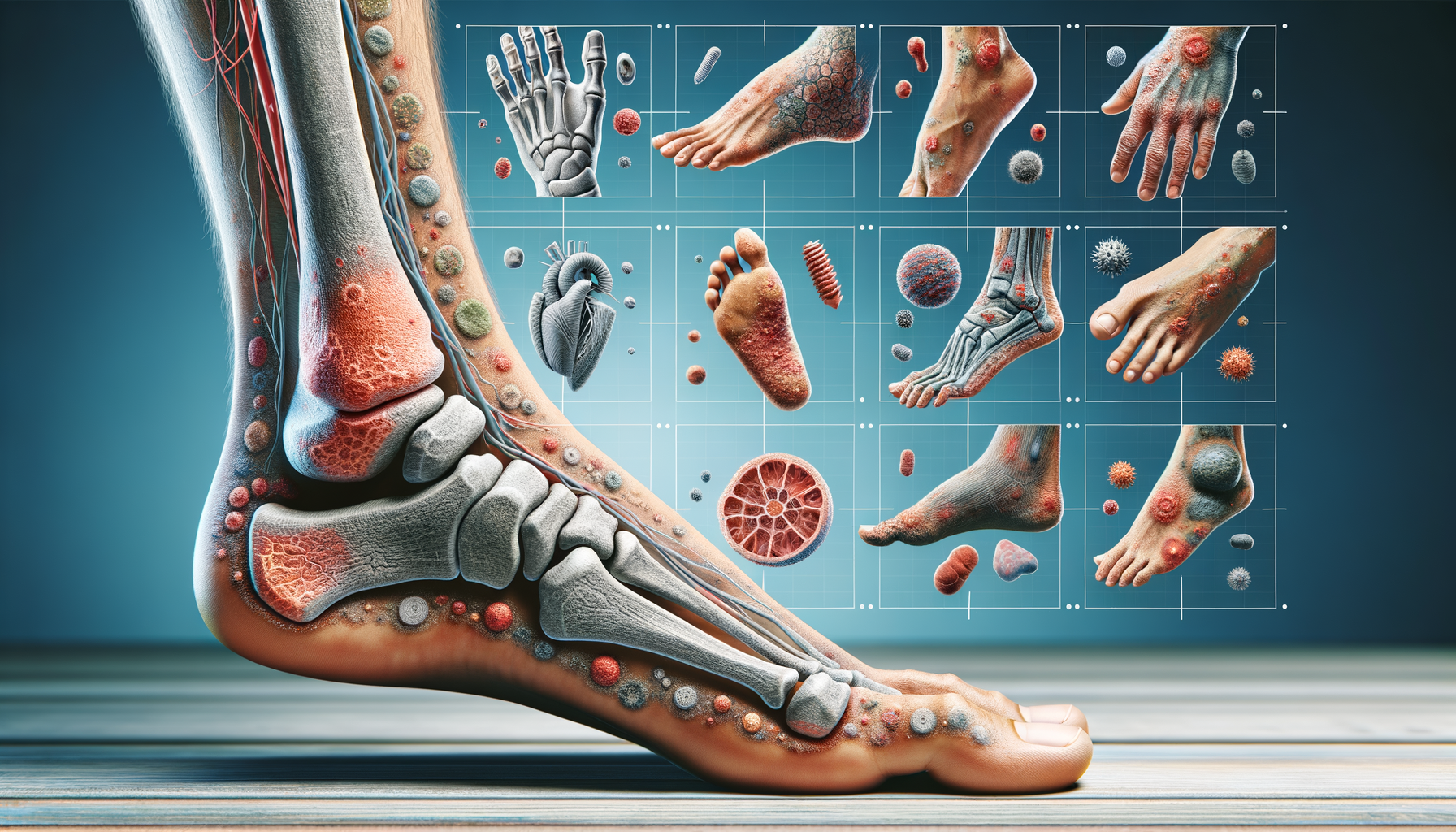Understanding Psoriatic Arthritis in the Feet
Psoriatic arthritis is a chronic condition that affects millions globally, characterized by joint pain, stiffness, and swelling. While it can impact any joint, the feet are particularly vulnerable. Identifying psoriatic arthritis symptoms in your feet is crucial for effective management and treatment. Early detection can significantly improve quality of life by preventing further joint damage and maintaining mobility.
The feet are complex structures, comprising numerous bones, joints, and soft tissues. This complexity makes them susceptible to the effects of psoriatic arthritis. Symptoms in the feet can vary widely, making it essential for individuals to be aware of the early signs. Common symptoms include swelling, pain, and changes in the nails, which can sometimes be mistaken for other conditions.
Understanding the specific symptoms associated with psoriatic arthritis in the feet can help in distinguishing it from other ailments. This knowledge empowers individuals to seek timely medical advice and initiate appropriate treatment strategies.
Common Symptoms of Psoriatic Arthritis in Feet
Psoriatic arthritis in the feet manifests in several ways, often affecting both the joints and the skin. One of the most noticeable symptoms is swelling, particularly in the toes, which can lead to a sausage-like appearance known as dactylitis. This swelling is not only uncomfortable but can also impede mobility.
Pain is another prevalent symptom, often exacerbated by movement or pressure. This pain can be persistent, affecting daily activities and overall quality of life. In some cases, individuals may experience stiffness, especially in the morning or after periods of inactivity.
Changes in the nails, such as pitting, discoloration, or separation from the nail bed, are also common in psoriatic arthritis. These changes can be distressing and may require specific treatments to manage effectively. Additionally, the skin on the feet may develop patches of psoriasis, characterized by red, scaly areas that can be itchy or painful.
Recognizing these symptoms early is vital for managing psoriatic arthritis effectively. Individuals experiencing any of these signs should consult a healthcare professional for a comprehensive evaluation and diagnosis.
Differences Between Psoriatic Arthritis and Other Foot Conditions
Distinguishing psoriatic arthritis from other foot conditions can be challenging due to overlapping symptoms. However, certain features are unique to psoriatic arthritis, aiding in its identification. Unlike other forms of arthritis, psoriatic arthritis often presents with both joint and skin symptoms.
While conditions like osteoarthritis primarily affect the joints, psoriatic arthritis involves inflammation of the skin and nails. This dual involvement can help differentiate it from other arthritic conditions. Additionally, the presence of dactylitis, or sausage-like swelling of the toes, is more characteristic of psoriatic arthritis.
Another distinguishing factor is the symmetrical nature of symptoms in psoriatic arthritis. Unlike other forms of arthritis, which may affect joints asymmetrically, psoriatic arthritis often impacts similar joints on both sides of the body.
Understanding these differences is crucial for accurate diagnosis and treatment. Healthcare professionals rely on a combination of clinical evaluation, medical history, and diagnostic tests to confirm psoriatic arthritis and rule out other conditions.
Impact of Psoriatic Arthritis on Daily Life
Living with psoriatic arthritis in the feet can significantly affect daily life, from mobility challenges to emotional well-being. The pain and stiffness associated with the condition can make walking and standing difficult, impacting work, exercise, and social activities.
Beyond physical limitations, psoriatic arthritis can also affect mental health. Chronic pain and visible symptoms like nail changes can lead to self-consciousness and social withdrawal. It’s not uncommon for individuals with psoriatic arthritis to experience anxiety or depression, highlighting the importance of a holistic approach to treatment.
Managing psoriatic arthritis requires a combination of medical treatment and lifestyle adjustments. Physical therapy, appropriate footwear, and regular exercise can help maintain mobility and reduce discomfort. Additionally, stress management techniques and support groups can provide emotional support and improve overall quality of life.
Understanding the comprehensive impact of psoriatic arthritis is essential for developing effective coping strategies and maintaining a fulfilling life despite the challenges posed by the condition.
Effective Management and Treatment Options
Managing psoriatic arthritis in the feet involves a multifaceted approach, combining medical treatments with lifestyle modifications. Early intervention is key to preventing joint damage and maintaining mobility.
Medical treatments typically include nonsteroidal anti-inflammatory drugs (NSAIDs) to reduce pain and inflammation. In more severe cases, disease-modifying antirheumatic drugs (DMARDs) or biologics may be prescribed to slow disease progression.
Lifestyle modifications play a crucial role in managing symptoms. Regular exercise, tailored to individual capabilities, can help maintain joint flexibility and strength. Choosing appropriate footwear that provides support and reduces pressure on the feet is also important.
Dietary changes, such as incorporating anti-inflammatory foods, can complement medical treatments and help manage symptoms. In addition, stress management techniques, such as meditation or yoga, can improve overall well-being and reduce flare-ups.
Collaborating with healthcare professionals to develop a personalized treatment plan is essential for effectively managing psoriatic arthritis. Regular monitoring and adjustments to the treatment plan can help address changing symptoms and maintain quality of life.




Leave a Reply